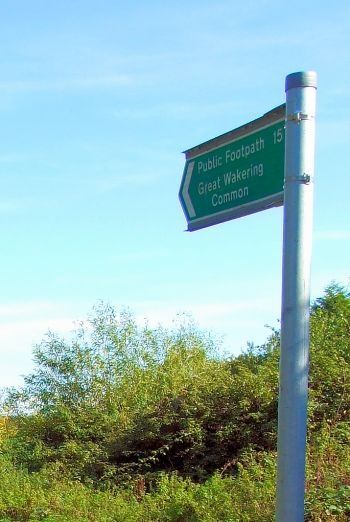
email: enquiries@greatwakering-pc.gov.uk
Services & Information
The Common

Great Wakering Common is a long stretch of common land to the east of St. Nicholas Church. It consists of rough open grassland and wetland. A drainage channel runs along the north of the Common and there is a necklace of ponds along the southern edge.
The Common may originally have been a tidal creek, which was cut off when the sea wall was originally built. The earliest records date from 1352, when a local landowner was prosecuted for restricting rights of access. Local villagers had rights to graze animals on the Common, a practice that continued into this century.
The development of the site from a creek and the prolonged grazing since then, have combined to make an unusual habitat and two plants occurring in the damp slightly salty grassland are rare in Britain. These are Divided Sedge and Spreading Meadow Grass. Since grazing has ceased on the Common, scrub and bramble have invaded and ponds and ditches have silted up. In the last war much of the ground was disturbed and there are now nettles and thistles growing in these areas.
Recent management has aimed to restore the appearance of the Common and its value for wildlife, by cutting the grass to discourage nettles, thistles and scrub; and by clearing ponds. The dyke along the south of the Common provides an interesting wetland habitat, with plants such as False Fox Sedges, Sea Club Rush and Common and Celery-Leaved Crowfoot.
Grass in this area is predominantly Sea Crouch, a plant tolerant of wet ground. A large stretch of suckering apple plants grow along the southern edge of the Common in this area, where it adjoins an old orchard. Divided Sedge, a small plant, rare in Britain, is prolific in areas of the Common. Another rare plant, Spreading Meadow Grass can be found. The areas of old pasture are rich with a diverse range of grasses and insects. Look out for the deep blue of the male Common Blue Butterfly (the female is more drab) and for the Skipper Butterflies which rest with their wings half open. Dock plants, Rushes, Silverweed and Willow-Herb are all good indicators of wetter ground. In disturbed ground thistles and nettles are abundant. Fennel, a tall plant with yellow flowers is also common. If the leaves from this plant are crushed they release a strong smell of aniseed. Flocks of colourful Goldfinches visit the Common in late summer and autumn to feed on the thistle and grass seed. In early summer listen for the frantic chattering calls of the Reed and Sedge Warblers, feeding among the reeds.